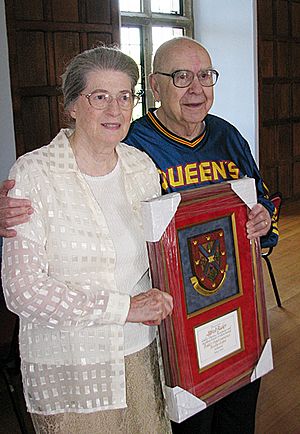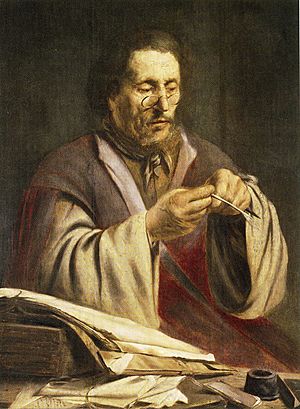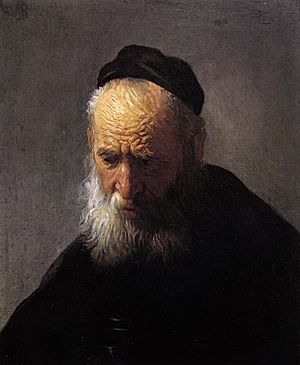Alfred Bader facts for kids
Quick facts for kids
Alfred Bader
|
|
|---|---|

Alfred R. Bader, recipient of the Pittcon Heritage Award, 2009
|
|
| Born | April 28, 1924 |
| Died | December 23, 2018 (aged 94) |
| Alma mater | Queen's University, Harvard University |
| Known for | Aldrich Chemical Company, Aldrichimica Acta |
| Spouse(s) |
Helen Daniels Bader
(m. 1952; div. 1981) |
| Awards | American Institute of Chemists Gold Medal (1997), Pittcon Heritage Award (2009) |
| Scientific career | |
| Fields | Chemistry |
| Doctoral advisor | Louis Fieser |
Alfred Robert Bader (April 28, 1924 – December 23, 2018) was a Canadian chemist, a successful businessman, a generous philanthropist (someone who gives money and time to help others), and a collector of fine art. Many people in the chemical world thought he was one of the most important people to contribute to chemistry in the last 75 years.
Contents
Early Life
Alfred Bader was born in Vienna, Austria, on April 28, 1924. His father was from a Jewish family in the Czech Republic, and his mother came from a noble Catholic family in Hungary. Alfred's father passed away just two weeks after he was born. Alfred was then adopted by his father's sister and raised in the Jewish faith. His older sister, Marion, stayed with their mother and was raised Catholic.
In June 1938, Alfred had to leave school because Jewish children over 14 were not allowed to attend. On December 10, 1938, he was sent from Austria to England as part of the Kindertransport. This was a rescue effort that saved thousands of Jewish children from Nazi persecution before World War II. His adoptive mother stayed in Austria and sadly died in a concentration camp in 1942.
While in England, Alfred went to school and college. In 1940, he was sent to a Canadian camp for European refugees. Even though the camp was simple, Alfred said it helped him with his studies and social skills. He took exams from McGill University and passed them while in the camp. In late 1941, a sponsor in Montreal helped him join a Canadian Jewish family, who encouraged him to continue his education.
Becoming a Chemist
Alfred wanted to go to university, but some places like McGill and the University of Toronto had rules that made it hard for Jewish students to get in. However, Queen's University in Canada accepted him. He earned a Bachelor of Science degree in Engineering Chemistry in 1945 and a Bachelor of Arts degree in History in 1946. During his summers, he worked at a paint company, learning to make different paints and varnishes.
He continued his studies at Queen's, earning a Master of Science degree in Chemistry in 1947. His work there, especially with his supervisor Arthur F. McKay, made him want to focus on creating new chemical compounds.
Alfred then went to Harvard University in the United States. He received a Master of Arts degree in Chemistry in 1949 and a Ph.D. (a very high-level degree) in Organic Chemistry in 1950. At Harvard, he worked with a famous chemist named Louis Fieser.
- Bachelor of Science in Engineering Chemistry, Queen's University (1945)
- Bachelor of Arts in History, Queen's University (1946)
- Master of Science in Chemistry, Queen's University (1947)
- Master of Arts in Chemistry, Harvard University (1949)
- Ph.D. in Organic Chemistry, Harvard University (1950)
Starting a Business
In January 1950, Alfred started working as a research chemist at Pittsburgh Plate Glass Co. (PPG). He did important work there, creating new chemical processes and materials. One of his inventions, a way to make diphenolic acid, was later sold by PPG for a lot of money.
During his time at PPG, Alfred noticed something important. There wasn't a good company that provided high-quality chemicals for scientists doing research. The main supplier, Kodak, didn't always have what smaller researchers needed. Alfred himself had trouble getting a specific compound he needed for his studies.
So, in 1951, while still working at PPG, Alfred co-founded the Aldrich Chemical Company with a lawyer named Jack Eisendrath. At first, they ran the company out of a garage, storing and packaging chemicals to send by mail. Alfred would buy interesting chemicals from different places and list them in his catalog. The very first product they sent out was a chemical called Methylnitronitrosoguanidine, which Alfred had learned to make at Queen's.
By 1954, Alfred and his first wife, Helen "Danny" Daniels, bought out Jack Eisendrath. Alfred became the company president and left his job at PPG.
Having reliable chemicals was super important for scientists. It saved them time and made sure their experiments could be repeated by others. The Aldrich Chemical Company's catalog eventually listed almost 50,000 different substances. It became known as a huge library of rare chemicals, plus thousands of common ones. Their "Big Red" annual catalog was even used as a reference book because it had so much useful information about the chemicals.
As the company grew, Aldrich Chemical Company merged with Sigma Chemical Corporation in 1975. The new company was called Sigma-Aldrich Corporation. Aldrich was known for chemicals used in organic research, and Sigma was known for chemicals used in biochemical research. Together, they became one of the largest chemical companies in the United States. Alfred Bader was the president of the combined company from 1975 to 1980, and then chairman until 1991.
In 1992, Alfred left his leadership role at the company. He later said that this change, though surprising at the time, gave him more time to focus on his art collection and his charity work, which made him even happier. The company later invited him back to help with their journal, Aldrichimica Acta, by providing paintings from his collection for the covers.
Art Collector
Alfred Bader once said, "I am an inveterate collector." This means he loved collecting things, and it started when he was young. He collected stamps at age eight, drawings at 10, paintings at 20, and rare chemicals at 30. He bought his first oil painting while in the Canadian internment camp. It was his own portrait, painted by another person in the camp, for just one Canadian dollar.
Alfred spent his life studying art history and collecting many beautiful paintings. In 1961, he opened an art gallery called Alfred Bader Fine Arts in Milwaukee. Starting in 1968, he wrote many articles about art for the Aldrich Chemical Company's journal, Aldrichimica Acta. The journal also featured full-color pictures of Dutch master paintings from Alfred's collection on its covers.
In 1995, Alfred published his autobiography, Adventures of a Chemist Collector. This book tells his story from being a refugee during the Nazi era to becoming a successful chemist and a lover of fine art. In 2008, he published another autobiography called Chemistry & Art - Further Adventures of a Chemist Collector.
Alfred Bader passed away at his home in Milwaukee on December 23, 2018.
Helping Others

Alfred Bader and his second wife, Isabel, were very generous. They gave many gifts, both money and art, to Queen's University in Canada. Alfred bought the 15th-century Herstmonceux Castle in England and donated it to Queen's University. The university opened Bader College there in 1994. A building at the college is named "Bader Hall" to honor him.
The Baders also created many scholarships and fellowships to help students. These include the Alfred Bader Graduate Fellowship and the Alfred and Isabel Bader Postdoctoral Fellowship in Jewish History. Queen's University also has three special teaching positions (called Chairs) named after Bader, focusing on chemistry and art. In 2004, Queen's even renamed a road on campus to "Bader Lane" to recognize his many contributions.
The Baders were also big supporters of the Agnes Etherington Art Centre at Queen's University. In 1967, Alfred donated his first painting to Queen's, a Salvator Mundi. In 2014, Alfred and Isabel donated 68 more paintings from their personal collection of Dutch and Flemish art. This brought the total number of paintings they donated to the center to over 200! Some of the most special paintings include three by the famous artist Rembrandt van Rijn.
The Baders also made a very large gift to help build the Isabel Bader Centre for the Performing Arts, which opened in 2014. This center has a music hall, a theater, a cinema, and many classrooms. It brings together different arts programs at Queen's University and provides a place for performances for both the university and the city.
At Victoria University, Toronto, which was Isabel Bader's university, the Baders helped fund the building of the Isabel Bader Theatre, a performing arts venue.
The Baders also supported Project SEED, a program that gives scholarships to high school students from less fortunate backgrounds. This program allows them to do hands-on research in science.
Since 2001, the Baders supported the Malta Conferences Foundation. This foundation uses science to help bring peace to the Middle East.
The Baders also funded several awards for excellence in chemistry, given by important chemical societies in America, the UK, and Canada.
In 2011, the Baders donated $1.6 million to help build a research complex at the University of Wisconsin–Milwaukee.
Awards and Honours
Alfred Bader received many awards and honors throughout his life, including:
Honorary Degrees
- Doctor of Science (DSc) from University of Wisconsin–Milwaukee (1980)
- Doctor of Science (DSc) from Purdue University (1984)
- Doctor of Science (DSc) from University of Wisconsin–Madison (1984)
- Doctor of Laws (LL.D.) from Queen's University (1986)
- Doctor of the University (DUniv) from University of Sussex (1989)
- Doctor of Science (DSc) from Northwestern University (1990)
- Doctor of Science (DSc) from University of Edinburgh (1998)
- Doctor of Science (DSc) from Glasgow University (1999)
- Doctor of Science (DSc) from Masaryk University (2000)
Memberships
- Wisconsin Academy of Sciences, Arts & Letters - Fellow (1986)
- Royal Society of Chemistry - Honorary Fellow (1990)
- Chemical Institute of Canada - Honorary Fellow (1996)
- Austrian Chemical Society - Honorary Membership (2002)
- Royal Society of Arts in London, England - Fellow
Medals and Awards
- American Chemical Society, Milwaukee Section - Award (1971)
- Winthrop-Sears Medal (1980)
- Czech Academy of Sciences - J.E. Purkyne Medal (1994)
- American Chemical Society - Charles Lathrop Parsons Award (1995)
- University of Vienna - Honorary Citizen (1995)
- Boron USA Award (1997)
- American Institute of Chemists Gold Medal (1997)
- Pittcon Heritage Award (2009)
- Commander of the Order of the British Empire
Family Life
Alfred Bader's life and marriages are described in his autobiographical books. He met Isabel Overton in 1949, and they had a strong connection, writing many letters to each other. Isabel later broke off their relationship for religious reasons.
Alfred then met and married Helen Ann "Danny" Daniels in the United States in 1952. They had two sons, David (born 1958) and Daniel (born 1961). Danny also worked at Aldrich Chemicals and owned shares in the company.
Years later, Alfred reconnected with Isabel. Alfred and Danny later divorced. Alfred then married Isabel, and they were happily married until his death. Alfred and Danny's two sons, David and Daniel, now help run Alfred Bader Fine Arts. They also lead Bader Philanthropies, a foundation that honors Helen Daniels Bader, Isabel Bader, and Alfred Bader, continuing their legacy of giving back.
See Also
- Aldrichimica Acta
- Sigma-Aldrich Corporation
|



